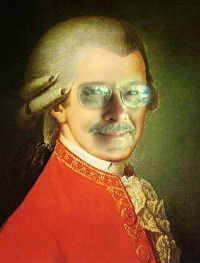A 365-Day Project
"We Are All Mozart"
A project to create
new works and change
the perception of the
music of our time.


 October 11, 2006
October 11, 2006 
"Must... not... repeat... must... not... repeat... must... not... repeat... must... not... repeat... "
That's what I wrote back to a composer last night. We had been tossing around the idea of repetition, and how useful it is in music, especially in the iPod era when repeating whole songs is reminiscent of the height of the Top 40 AM radio days. But repetition comes in many shapes & sizes, purposes & guises. Tradition, memory aid, laziness. Emphasis, sensation, sales. Suggestion.
Most broadly, repetition suggests a wholesale restatement, a stamped-out replica. But as soon as my toes breached the water's skin, the depth of the repetition pool was revealed, and though the water looked clear, soon it will rise and I'm gonna drown 'cause I know it's gonna rain. It's gonna rain. It's gonna rain after awhile.
Length first. Years, seasons, months, days, tides, waves, heartbeats, purrs, howls -- natural repetitions, from long to short. And somewhere within comes the rhythmic repetition of sticks on skins that emulates the heartbeat and inflames it, and above it the story told with a rhythmic memory cycle, and its assonant or rhyming mnemonic. Whatever pleases in the hypnotic chant of Greek chorus or traveling trouvère is the source of the long repetition, the stanza, the melody. And tucked inside are the fragments of similarity, the melodic or rhythmic phrases that are shaped identically or merely almost alike. And swimming with the flow of time slows it enough to reveal the gesture, the familiar fragment of cross-cultural communication ("Wehe!" cries in any language).
(I'm trying not to rush ahead, but consider that our attention span has shortened and deepened at once, and the long repetition seems almost deranged.)
The repetition of melody is the theme. Its repetition can be sequentially duplicate over time, the A or the B of poetry and song. It can be horizontally responsive within itself -- the sequence. It can be repeated in vertical staggering, in canon and stretto. Melodic, thematic, motivic.
From there the river comes to a delta, a hundred islands of variation. The poetic forms of the Ars Nova were marvelous, such as the complex virelai, whose repetition turned upon itself. The cantus firmus, any one of many well-known melodies calling out through the middle of the counterpoint, bound together thousands of Masses. The nearly forgotten isorhythm played upon the unbalanced relationship of independent melody and rhythm, disguising an old melody as a new one as its metrical feet slipped out from under it. The fugue spilled out melodies at fifths and fourths and octaves and turned upside down and backwards, mirrors and crabs -- sometimes recognizable, sometimes merely a conceit, a numbers game, a paean to cleverness. And not to forget the ostinato underpinning, a basso profundo of the cantus firmus, the passacaglia and its relentless repetition that stretched from Purcell to Brahms.
But the formal repetition -- the one to which my objection caused a stir of compositional response -- began in (and should belong to) the classical era, when the rude song & dance became an ossified rondo or, at the extreme, the formal and repeated exposition, its struggle at development, and what-a-good-boy-am-I recapitulation.
Before a closer look at the traditional repetition, there are others to list: the rhythmic repetition (most well known in Beethoven's Seventh, about which composer Lydia Busler-Blais speaks eloquently; her words will also be quoted below) and the near-variation of a mature rondo. In more recent times, the tone-row formed a repetitive structure that girded entire compositions, a Versailles of dark looking-glass Hauptstimmen and Nebenstimmen that looked alike but could hardly be discerned in the air. The minimalist times first conjoined the tranced repetition of sonic modules (In C) with slipping looped phases (It's Gonna Rain); electroacoustics ushered in genetic and fractal petri-dish repetitions of source phrases; and even the encapsulated textures of single samples à la Creshevsky created weaves of microscopic repetitions.
What purpose do these repetitions serve, any of them? The question seems valid on its surface because repetition appears in no other artform, except poetry, which has itself slipped toward the free and the blank. In novels? In film? (Are Woody Allen's references to Eisenstein repetition or homage?) How about in painting -- unless one considers the Pointillists a precurser in paint of Creshevsky in sound. Scupture? Maybe a Roman frieze or a temple of virgin statues? Okay, ballroom dance or square dance or even Lord of the Dance, but how much from Graham and Nijinsky through Cunningham and Tharp?
No, it's not necessary. We have learned to know the 'theme', to discern from flashback/forward and all manner of postmodernist expression, without the need for a composer-as-lecturer. We can follow the compositional transformation or development or migration (or even meandering New Age and pseudo-World styles) without pandering. Certainly as composers we do love our themes. Got a good one, keep it. A hook is good, too. But the verse, the repeated module, and the hook are all part of a temporal devolution following the industrial, post-industrial, technological and post-technological culture with its identically stamped out cars and burgers and Nikes and iPods. It gets smaller until ... poof!
It seems to me that exposition-development-recapitulation, or verse-chorus-verse-chorus, or near-identical rondo or theme and transparent variations are exhausted, and expose the simple lack of economy (and yes, that's a nape-riser there) in nonpop composition. Yes, one can do repetition when it makes great sense, offers deeper meaning, effects magnificent impact -- but not as a default condition when the concepts have been poorly expressed and require a 'reminder'. If Salman Rushdie or Robertson Davies or T. C. Boyle need no repetition, why do composers? For tradition's sake? For lack of imagination? For fear our already lost audiences will be further lost?
Okay, take it, Lydia:
|
A precedent for repetition can be observed most blatantly in the second movement of Beethoven's Seventh Symphony. While we can perhaps fault the King of the Cadence that Never Ends for beating a good thing To Death, here is a development that would have neither the emotional impact nor thematic punch without the progression it takes. We start with a subtle but strong rhythmic statement barely outlined in a minor. A melody is added, then more counter melody, all the while anchored by this rhythmic pulse. The march becomes stronger and more imploring, eventually sweeping the listener into a large wave of a pulsing elaborated minor dirge as built on the same rhythm and the same melody and the same countermelodies and harmonies storming forth together. The effect of this repetitive development is nearly overwhelming... then suddenly we've stopped, tiptoe in discomfort for a moment, and we're off to Happy Land, only to be wrenched back later and ultimately winding down to that small and lonely place of pensive sadness where we started - you know it, you know how it's done. |
This is a singularly brilliant defense of repetition, accomplished by choosing an example where repetition is integrated with the concept to such a degree that the development seems impossible without that insistent cycle of beats. This movement is almost unique in the history of music, along with the Chopin Marche Funèbre from the B-flat minor sonata. But this also speaks to the inevitability of what we already know. Like the lecture in which Bernstein disemboweled Beethoven's Fifth Symphony, the inevitability is a combination of expert choices, brilliant insight -- and historical memory, the repetition of the entire piece in performance for the past 193 years. This is neither a dismissal of the Seventh nor of Lydia's powerful defense of it -- just that the cultural and musical characteristics that fashioned Beethoven and Chopin and their work are no longer the same characteristics that fashion ours.
I'm reversing Lydia's order because her most insightful point came earlier in the missive:
|
Abiding by a steadfast rule not to reiterate one's thematic material, whether melodic, harmonic, textural, rhythmic, contrapuntal, etc. is as highly limiting as to say that one must repeat this material. Likewise to say that it is good to expound on one of these elements, say the same rhythmic material, but not another discrete element, say the same melodic material, is to say that one has a different value than the other and I don't believe this to be so. I suspect that you shun repetition of a theme in part because you do not wish to encourage the conclusion that one element is more important than another or than the whole itself, yet denial of ability to freely repeat an element of a musical work is to assign to it a value different from that of other elements. The music is the conjured combination of each of these and other elements that the performer expresses. No less. When you take away the ability to reiterate an element of thematic material in part, the ability of the composer to create differences in character subtle to monumental while still being tied to that element is stymied. In fact, when a performer has the chance to repeat material within a single performance that performer can vary the material in subtle or capital ways, both with great possibilty for effectiveness! |
Lydia-as-performer speaks, and there is substance here that I too often forget. The intermediation is accomplished by the performer, and the performer benefits from the ability to rephrase, restate, and reconsider in the performer's own theme and variations. (This, by the way, validates a whole stream of thought on electroacoustic composition as freeing itself from such performance issues; another time for that.)
Now just to be clear, I don't shun repetition for the point Lydia makes, nor in the way she suggests it; in fact, for a piece she commissioned last year, near-repetition formed an important part in the piece developed. My point is rather that repetition is a Venus flytrap or a pitcher plant. Once you're doing it unconsciously, it's too late. You've fallen in and the composition is already being digested. To survive the digestive juices, it's necessary to avoid being trapped -- to conceptualize the piece's process or structure or movement in an original way. Lydia's point about music being 'the conjured combination' is in play here, but since there is only magic if the creation survives, conjuring demands a well-trained hand and eye and ear and prescience -- for repetition is the first choice of a debilitated imagination.

Autumn leaves: Every one a repetition of the other, every one different from the other.